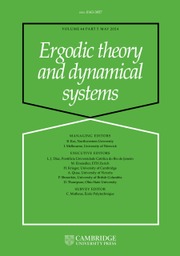No CrossRef data available.
Article contents
Directional dynamical cubes for minimal  $\mathbb{Z}^{d}$-systems
$\mathbb{Z}^{d}$-systems
Published online by Cambridge University Press: 26 June 2019
Abstract
We introduce the notions of directional dynamical cubes and directional regionally proximal relation defined via these cubes for a minimal  $\mathbb{Z}^{d}$-system
$\mathbb{Z}^{d}$-system  $(X,T_{1},\ldots ,T_{d})$. We study the structural properties of systems that satisfy the so-called unique closing parallelepiped property and we characterize them in several ways. In the distal case, we build the maximal factor of a
$(X,T_{1},\ldots ,T_{d})$. We study the structural properties of systems that satisfy the so-called unique closing parallelepiped property and we characterize them in several ways. In the distal case, we build the maximal factor of a  $\mathbb{Z}^{d}$-system
$\mathbb{Z}^{d}$-system  $(X,T_{1},\ldots ,T_{d})$ that satisfies this property by taking the quotient with respect to the directional regionally proximal relation. Finally, we completely describe distal
$(X,T_{1},\ldots ,T_{d})$ that satisfies this property by taking the quotient with respect to the directional regionally proximal relation. Finally, we completely describe distal  $\mathbb{Z}^{d}$-systems that enjoy the unique closing parallelepiped property and provide explicit examples.
$\mathbb{Z}^{d}$-systems that enjoy the unique closing parallelepiped property and provide explicit examples.
MSC classification
Information
- Type
- Original Article
- Information
- Copyright
- © Cambridge University Press, 2019


